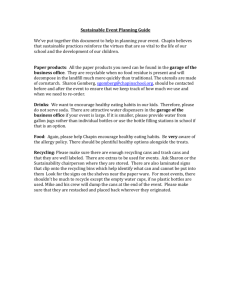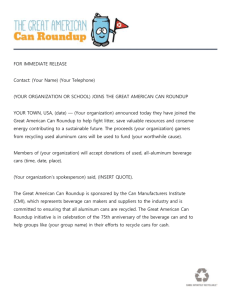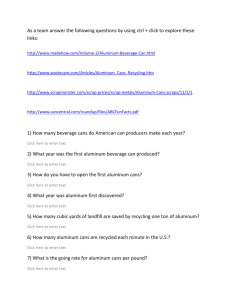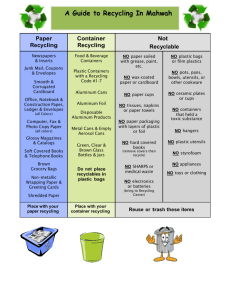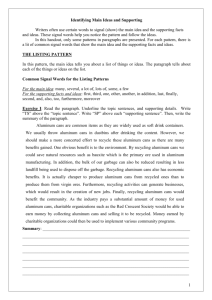doc 212 KB - Container Recycling Institute
advertisement
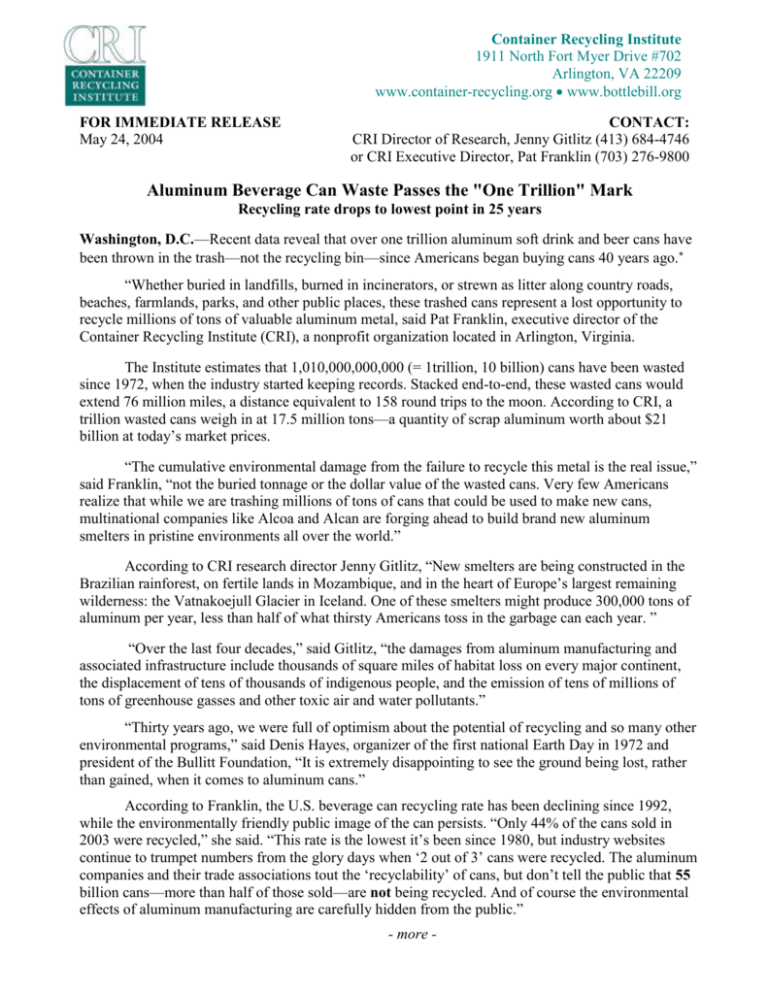
Container Recycling Institute 1911 North Fort Myer Drive #702 Arlington, VA 22209 www.container-recycling.org www.bottlebill.org FOR IMMEDIATE RELEASE May 24, 2004 CONTACT: CRI Director of Research, Jenny Gitlitz (413) 684-4746 or CRI Executive Director, Pat Franklin (703) 276-9800 Aluminum Beverage Can Waste Passes the "One Trillion" Mark Recycling rate drops to lowest point in 25 years Washington, D.C.—Recent data reveal that over one trillion aluminum soft drink and beer cans have been thrown in the trash—not the recycling bin—since Americans began buying cans 40 years ago. “Whether buried in landfills, burned in incinerators, or strewn as litter along country roads, beaches, farmlands, parks, and other public places, these trashed cans represent a lost opportunity to recycle millions of tons of valuable aluminum metal, said Pat Franklin, executive director of the Container Recycling Institute (CRI), a nonprofit organization located in Arlington, Virginia. The Institute estimates that 1,010,000,000,000 (= 1trillion, 10 billion) cans have been wasted since 1972, when the industry started keeping records. Stacked end-to-end, these wasted cans would extend 76 million miles, a distance equivalent to 158 round trips to the moon. According to CRI, a trillion wasted cans weigh in at 17.5 million tons—a quantity of scrap aluminum worth about $21 billion at today’s market prices. “The cumulative environmental damage from the failure to recycle this metal is the real issue,” said Franklin, “not the buried tonnage or the dollar value of the wasted cans. Very few Americans realize that while we are trashing millions of tons of cans that could be used to make new cans, multinational companies like Alcoa and Alcan are forging ahead to build brand new aluminum smelters in pristine environments all over the world.” According to CRI research director Jenny Gitlitz, “New smelters are being constructed in the Brazilian rainforest, on fertile lands in Mozambique, and in the heart of Europe’s largest remaining wilderness: the Vatnakoejull Glacier in Iceland. One of these smelters might produce 300,000 tons of aluminum per year, less than half of what thirsty Americans toss in the garbage can each year. ” “Over the last four decades,” said Gitlitz, “the damages from aluminum manufacturing and associated infrastructure include thousands of square miles of habitat loss on every major continent, the displacement of tens of thousands of indigenous people, and the emission of tens of millions of tons of greenhouse gasses and other toxic air and water pollutants.” “Thirty years ago, we were full of optimism about the potential of recycling and so many other environmental programs,” said Denis Hayes, organizer of the first national Earth Day in 1972 and president of the Bullitt Foundation, “It is extremely disappointing to see the ground being lost, rather than gained, when it comes to aluminum cans.” According to Franklin, the U.S. beverage can recycling rate has been declining since 1992, while the environmentally friendly public image of the can persists. “Only 44% of the cans sold in 2003 were recycled,” she said. “This rate is the lowest it’s been since 1980, but industry websites continue to trumpet numbers from the glory days when ‘2 out of 3’ cans were recycled. The aluminum companies and their trade associations tout the ‘recyclability’ of cans, but don’t tell the public that 55 billion cans—more than half of those sold—are not being recycled. And of course the environmental effects of aluminum manufacturing are carefully hidden from the public.” - more - One Trillion Cans Wasted Page 2 of 2 “Replacing the estimated 820,000 tons of cans wasted in 2003 with new cans made from virgin materials will unnecessarily consume the energy equivalent of 26 million barrels of crude oil, and will generate over 3.4 million tons of greenhouse gas emissions,” Gitlitz said. “Ironically, the trillionth can wasted coincides with the 40th anniversary of the aluminum beverage can,” Gitlitz said. “In failing to recycle more than one trillion cans in the last 40 years, we have squandered the energy equivalent of over 550 million barrels of crude oil—enough to supply the total residential energy needs of about 35 million American homes for a year. Replacing these wasted cans with new cans made from bauxite ore and electricity has also produced over 70 million tons of greenhouse gas emissions.” Changing consumer habits are partially responsible for the rising tide of container waste, explained Gitlitz. “In 1992 when aluminum can recycling peaked at 65%, people were still doing most of their food and beverage consumption—and their recycling—at home. More people eat and drink on the go today, and as a result, the aluminum can recycling rate has dropped well below 50%.” “Access to curbside recycling has tripled over the last 12 years,” Gitlitz said, “but residential recycling programs simply can’t be expected to target all the beverages being consumed away from home.” “The recycling picture is getting worse, not better, but it could be turned around,” she said. “We could achieve a recycling rate of 80-90% with a national bottle bill.” According to Franklin, “Beverage container deposit laws, or ‘bottle bills,’ exist in eleven U.S. states, and the 5¢ or 10¢ refundable deposit on beverage bottles and cans routinely achieves recycling rates of 70% to 95%.” “But the soft drink, beer, and grocery industries use their political clout to lobby against deposit systems, preferring taxpayer-funded residential programs. Until the beverage companies and bottlers come forward and take responsibility for their beverage cans, the waste will continue and taxpayers will foot the bill,” said Franklin. ### About the Container Recycling Institute (CRI): CRI is a 501(c)3 non-profit national organization that studies beverage container sales and recycling trends, and promotes policies to reverse wasting. CRI provides technical information and analysis to students, activists, policymakers, and the media. The organization is supported primarily by foundations, with support from businesses, organizations and individuals. Experts available for interview: Jenny Gitlitz: home office (413) 684-4746; cell (413) 822-0115; jgitlitz@container-recycling.org Pat Franklin: office (703) 276-9800; cell (703) 304-3546; pfranklin@container-recycling.org The first disposable all-aluminum cans were marketed in 1964, but the Aluminum Association, an industry trade group, only began collecting sales and recycling data in 1972. Since 1990, the Container Recycling Institute has used U.S. Department of Commerce data to adjust the Aluminum Association recycling rate to account for imported scrap cans (cans not originally sold in the United States). This adjustment is consistent with the U.S. Environmental Protection Agency Office of Solid Waste’s method of calculating recycling rates for other materials in the wastestream. Details on the calculation methods, total number of cans wasted, and environmental impacts cited here are available from CRI.

